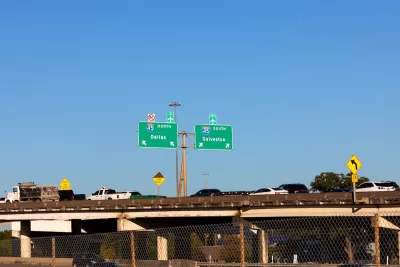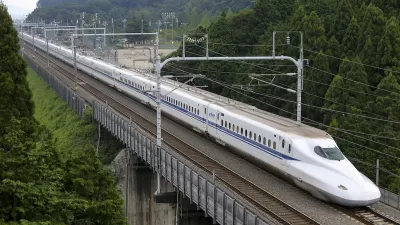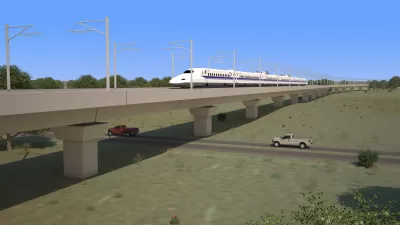The proposed rail line would link Dallas and Houston via a 90-minute trip.

Updated September 20 to include a response from the North Central Texas Council of Governments.
Texas officials say they will use eminent domain to acquire land needed for the 240-mile high-speed rail line planned between Dallas and Houston, reports Hugh Cameron in Newsweek. The Texas Supreme Court ruled that the project’s builder had eminent domain authority in one Leon County case in 2022.
According to a proposal presented to the Regional Transportation Council of the North Central Texas Council of Governments, the project requires the creation of a statewide high-speed rail authority. “This, they state, would require ‘provid[ing] counties and cities with expanded tools for land use control to preserve future transportation corridors and support land use, housing, school, and transportation connection policies that best serve growth needs.’” According to Texas Central, the train could remove up to 12,500 cars from Interstate 45 each day.
The project has gained momentum in recent months, with the federal government awarding Amtrak a $64 million grant for the line earlier this month, but its total estimated cost has gone up from $10 billion to over $33 billion as of a 2023 study.
In an email to Planetizen, a spokesperson for the North Central Texas Council of Governments clarified, “While the draft legislative proposal mentions eminent domain, it does so in the context of calling for continued support for the current statutory authority for local governments involved in the development of a freeway project, not high-speed rail. The goal is to retain local control of something that already exists.” The email also noted that the creation of a statewide high-speed rail authority is just one proposed avenue for moving the project forward.
FULL STORY: Texas Lawmakers Plan To Seize Land for Bullet Trains

Study: Maui’s Plan to Convert Vacation Rentals to Long-Term Housing Could Cause Nearly $1 Billion Economic Loss
The plan would reduce visitor accommodation by 25,% resulting in 1,900 jobs lost.

North Texas Transit Leaders Tout Benefits of TOD for Growing Region
At a summit focused on transit-oriented development, policymakers discussed how North Texas’ expanded light rail system can serve as a tool for economic growth.

Why Should We Subsidize Public Transportation?
Many public transit agencies face financial stress due to rising costs, declining fare revenue, and declining subsidies. Transit advocates must provide a strong business case for increasing public transit funding.

How to Make US Trains Faster
Changes to boarding platforms and a switch to electric trains could improve U.S. passenger rail service without the added cost of high-speed rail.

Columbia’s Revitalized ‘Loop’ Is a Hub for Local Entrepreneurs
A focus on small businesses is helping a commercial corridor in Columbia, Missouri thrive.

Invasive Insect Threatens Minnesota’s Ash Forests
The Emerald Ash Borer is a rapidly spreading invasive pest threatening Minnesota’s ash trees, and homeowners are encouraged to plant diverse replacement species, avoid moving ash firewood, and monitor for signs of infestation.
Urban Design for Planners 1: Software Tools
This six-course series explores essential urban design concepts using open source software and equips planners with the tools they need to participate fully in the urban design process.
Planning for Universal Design
Learn the tools for implementing Universal Design in planning regulations.
Ascent Environmental
Borough of Carlisle
Institute for Housing and Urban Development Studies (IHS)
City of Grandview
Harvard GSD Executive Education
Toledo-Lucas County Plan Commissions
Salt Lake City
NYU Wagner Graduate School of Public Service





























